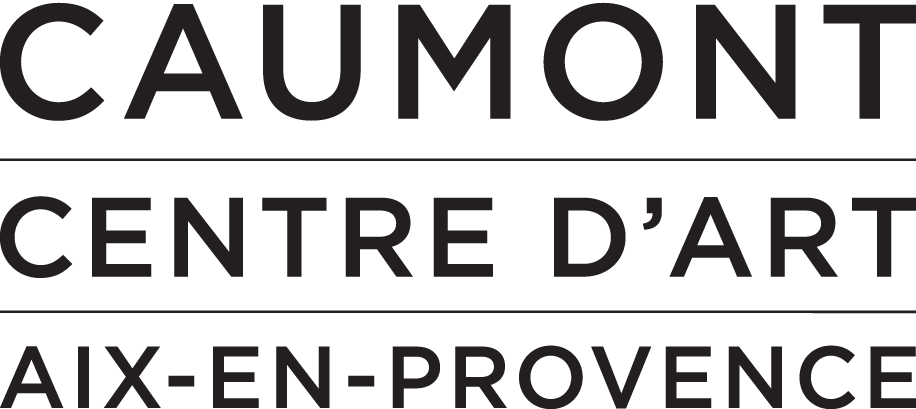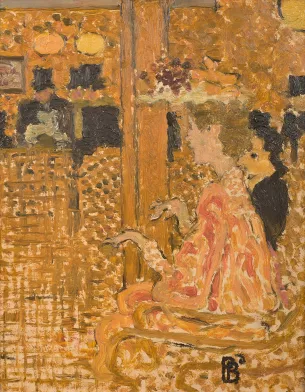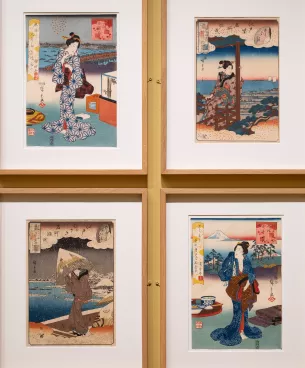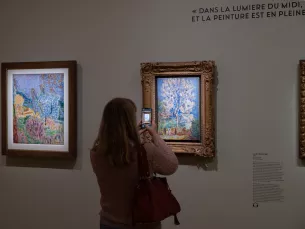Due to high visitor numbers at weekends and during school vacations, online booking is strongly recommended. If you wish to purchase on site, please allow plenty of time for waiting.
Exhibition
Bonnard et le Japon
In 2024, Caumont - Art Centre will dedicate its summer exhibition to the genius of Pierre Bonnard and the influence on him of Japanese art. This will be the first exhibition on the subject, showing how Bonnard – once known as the “Nabi très japonard” (very Japanese Nabi) – assimilated the aesthetics of Japanese art into his treatment of space, time and movement, creating works that renounced naturalism and impressionism. Works by the French painter will be exhibited alongside Japanese prints to illustrate the similarities and formal affinities between them, and the importance for Bonnard of this source of inspiration.
A member of the Nabi group, at the end of the 19th century, Pierre Bonnard (1867–1947) shook up the development of artistic modernity with the subtlety of his representation of visual sensations. Bonnard divided his time between the Paris region, Normandy and Isère, as well as the Côte d’Azur, where he bought a house in Le Cannet, near Aix-en- Provence. The bustling life of cities, the pleasures of country life, and landscapes bathed by the golden light of the Midi were all pretexts for the artist to develop a new manner of depicting movement, and for farreaching reflection on the treatment of colour, the fleeting feelings of everyday life, and the beauty of nature. His vibrant works reveal an unmatched understanding of colour and its infinite variations.
Beginning in the 1860s, for a period of almost half a century, a vogue for all things Japanese spread through France and then England, in particular as a result of Japan’s participation in the 1867 World’s Fair. Bonnard was interested very early on by the characteristics of Ukiyo-e prints, a Japanese term meaning “image of the floating world”. The exhibition of Japanese prints at the École des Beaux-arts in the spring of 1890 was a true revelation for him, marking the moment when he turned his attention away from the representation of reality and embraced new aesthetic principles, such as the fluidity of movement, contrasting colours, sinuous lines, a pronounced fondness for decoration and stylised elements, and the flattening of space. From that time on, his style was truly marked by japonisme, a term coined in 1872 by Philippe Burty to refer to the influence of Japan on Western art.
Through this exhibition, the public will have the opportunity to (re) discover Bonnard’s works and a selection of Japanese prints from the prestigious Leskowicz Collection, to understand how Bonnard’s style remains always strongly influenced by Japanese concepts and aesthetics. A dynamic presentation will illustrate how works by artists, though remote from one another in time, space and culture, raise similar aesthetic questions and express ideas, emotions and situations that display many common characteristics. Very quickly, Japan put Bonnard on the path of colour, light, the instantaneous and the expression of transient feelings.
This exhibition benefits from generous loans from the Musée Bonnard.
The team
Curatorship
Isabelle Cahn, is an art historian, Emeritus Chief Curator of Paintings at the Musée d’Orsay and specialist in the art of the late 19th and early 20th centuries. The curator of numerous exhibitions in Paris and abroad, she is an expert on the Post-Impressionist movement, the Nabis in particular, and Van Gogh. She has also organised exhibitions devoted to such outstanding personalities as Lugné-Poe, Misia Godebska, Félix Fénéon and Marcel Proust. She is also a scientific editor of exhibition catalogues and the author of books, essays and articles on the art of the late 19th and early 20th centuries. She recently published a monograph on Bonnard (Citadelles & Mazenod, 2023).
Production and creation
Emmanuelle Lussiez, Director of Exhibitions at Culturespaces; Milly Passigli, Deputy Director of Exhibition Programming; Madeleine Balansino, Head of Exhibitions at Caumont-Art Centre; Livia Lérès and Domitille Sechet responsible for iconography at Culturespaces.
Scenography
Hubert Le Gall is a French designer, artist, and contemporary art sculptor. He has created original set designs for numerous exhibitions, notably at Caumont - Art Centre and the Jacquemart-André Museum.


























